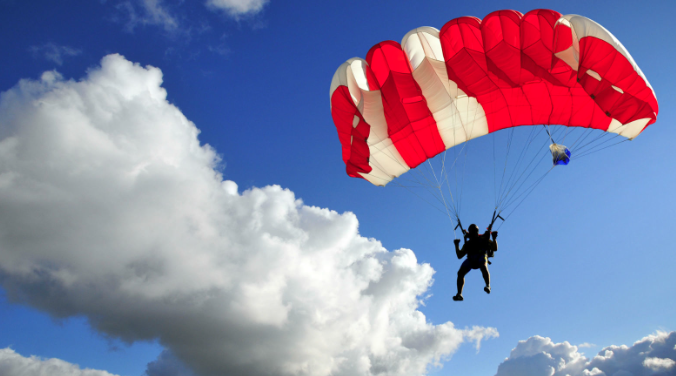How to Design a Parachute
This post is also inspired by the excellent book by Robert Banks – Towing Icebergs. This book would make a great investment if you want some novel ideas for a maths investigation.
The challenge is to design a parachute with a big enough area to make sure that someone can land safely on the ground. How can we go about doing this? Let’s start (as in the last post) with some Newtonian maths.
Newton’s Laws:
For an object falling through the air we have:
psgV – pagV – FD = psVa
ps = The density of the falling object
pa = The density of the air it’s falling in
FD = The drag force
g = The gravitational force
V = The volume of the falling object
a = The acceleration of the falling object
Time to simplify things
Things look a little complicated at the moment – luckily we can make our lives easier through a little simplification. pa will be many magnitudes smaller than than ps – as the density of air is much smaller than the density of objects like cannonballs. Therefore we ignore this part of the equation, giving an approximate equation:
psgV – FD ≈ psVa
We now rewrite things to make it easier to substitute values in later.
psV = m, where m = mass of an object (as density x volume = mass)
This gives:
mg – FD ≈ ma
and as mg = W (mass x gravitation force = weight) we can rewrite this as:
W – FD ≈ (w/g)a
Now, the key information to know when looking at a parachute design is the terminal velocity that will be reached when the parachute is open – that means the maximum velocity that a parachutist will potentially be hitting the ground traveling.
Now, when a person is traveling at terminal velocity their acceleration is 0, so we can set a = 0 in the equation above to give:
W – FD = 0
Now we need an equation for FD (the drag force).
FD = 0.5paCDAU2
where
pa = density of the air
CD = the drag coefficient
A = area of parachute
U = velocity
So
when the parachutist is traveling at their terminal velocity with the parachute open we have:
W – FD = 0
W = 0.5paCDAU2
OK, nearly there. Next thing to consider is what is the maximum velocity we want someone to be traveling when they hit the ground. This is advised to be around 5 m/s – similar to jumping from a 2 metre ladder. Much more than this and you would risk breaking a bone (or worse!)
So we are finally ready to solve our equation. We want to find what value of A (the area of the parachute) will make us land safely.
We have:
pa = 0.6kg/m3 (approximate density of air at 3000m)
CD = 1.40 (a calculated drag coefficient for an open parachute)
U = velocity = 5m/s (this is the maximum velocity we want to want to avoid injury)
W = 100kg (we will have this as the combined weight of the parachutist and the parachute)
So,
W = 0.5paCDAU2
100 = 0.5(0.6)(1.40)A(5)2
A = 9.5m2
So if we had a circular parachute with radius 1.7m it should slow us down sufficiently for us to land safely.
IB teacher? Please visit my new site http://www.intermathematics.com ! Hundreds of IB worksheets, unit tests, mock exams, treasure hunt activities, paper 3 activities, coursework support and more. Take some time to explore!
Are you a current IB student or IB teacher? Do you want to learn the tips and tricks to produce excellent Mathematics coursework? Check out my new IA Course in the menu!

Could you please do my maths exploration?
Oh, I want you to do mine, also!